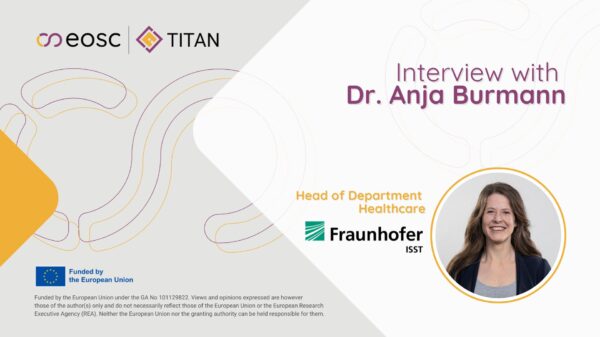Funded by the European Commission, TITAN (Trusted envIronments for confidenTiAl computiNg and secure data sharing) it’s a 36-month project that will deliver an open-source software platform focused on enabling secure sensitive data sharing, and demonstrate them in the EOSC ecosystem.
An interview with Dr. Anja Burmann, Head of Department Healthcare at the Fraunhofer Institute for Software and Systems Engineering ISST, a vital partner in the TITAN project, is now available. As a global leader in applied research, Fraunhofer brings decades of invaluable experience in secure data infrastructures and data spaces to the project.
Dr. Anja Burmann’s expert perspective provides insight on how the TITAN project can influence the practical adoption of confidential computing. The discussion also covers the critical role of data sovereignty, opportunities for technology transfer into the broader European data economy, and a visionary outlook on how TITAN can improve the accessibility and utilisation of data across Europe.
“Trust mechanisms for leveraging data will enable innovation and new business models, making Europe more competitive and ensuring personalised, equal care.”

What motivated Fraunhofer ISST to become a partner in the TITAN-EOSC project?
Our goal is to develop processes that facilitate the secure, cross-organisational exchange of data. Fraunhofer, particularly Fraunhofer ISST, recognises the enormous potential of data spaces for enabling such scenarios in science, industry and politics. Therefore, contributing to a project within the Common European Data Spaces seemed like an obvious next step, particularly focusing on our core area of expertise: research methods in healthcare (Use Case 2).
Can you briefly describe your organization’s main role and key responsibilities within the TITAN-EOSC project?
Fraunhofer ISST contributes its expertise in data spaces to realise the intended use cases, based on relevant technical requirements. Fraunhofer also promotes standardisation and the transfer of knowledge to science and industry.
Given Fraunhofer’s position as a global leader in applied research and its significant contributions to secure data infrastructures, how do you see the TITAN-EOSC project influencing the practical adoption of confidential computing across various scientific disciplines within the EOSC, beyond just its technical specifications?
Confidential computing establishes trust when collaborating with data. TITAN demonstrates how technical and organisational measures can facilitate such collaboration between companies and organisations. Data sovereignty is therefore an inherent requirement in Europe, forming the basis for fair market access and competition, as well as the protection of individual and organisational security requirements. Enabling both will lay the groundwork for joint data value creation in Europe in the future.
Fraunhofer consistently bridges the gap between cutting-edge research and industrial application. What are the primary opportunities for technology transfer and real-world impact that Fraunhofer identifies for the innovations developed within TITAN-EOSC, particularly in fostering secure data collaboration in the broader European data economy?
The EU Commission has already outlined the European Health Data Space in the healthcare sector. This emphasises the need for Secure Processing Environments. TITAN’s approach to this issue incorporates many ideas and principles. I see an opportunity to create solutions that enable the use of data without granting direct access to the original data.
What is your vision for the long-term impact of the TITAN-EOSC platform on the broader research community and the EOSC ecosystem?
TITAN can improve the accessibility and utilisation of data in Europe. Privacy-enhancing technologies can preserve individuals’ rights while creating added value for research. The aim is to create a platform that will enable entirely new insights and make data sharing an integral part of business models and mindsets.
If you had to describe the project in a few words, what would it be?
Collaboration.
👉 Follow TITAN today and be up to date with all the project’s developments.
👉 Join TITAN’s community on X (@titan_eosc) & on LinkedIn (@titan-eosc)